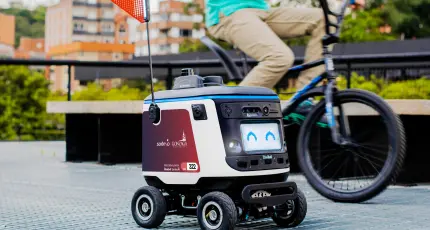Kiwibot, the robotic sidewalk delivery startup, has announced a partnership with food services and facilities management giant Sodexo to bring its robots to U.S. college campuses. As of this month, students and faculty at New Mexico State University, Loyola Marymount University and Gonzaga University should have the option to order fresh meals via cute little robots from Sodexo-serviced locations on campuses.
This is not the first time Kiwibot is delivering food for over-caffeinated, hungover, exhausted college kids. Its robots, which are designed to look adorable and can move at around two miles per hour, were born at the University of Berkeley, California. There, the company was able to rack up 150,000 deliveries and prove its use case for expansion to other campuses, like the University of Denver and Stanford University.
Sodexo provides the food for the cafeterias and dining halls of hundreds of colleges across the U.S., so this partnership could prove to be massively fruitful for Kiwibot. It’ll need the boost in order to keep up with its main competition, Starship Technologies, which completed one million delivery rides in January and operates in many college campuses, as well.
Former head of Alphabet’s Loon joins Starship Technologies as new CEO
Campuses are often a natural choice for startups in autonomous development. Not only are universities open to experimenting with new ideas, but given the unit economics on a campus, the revenue growth prospects are more favorable than working B2B in a city, says Diego Varela Prada, chief operating officer at Kiwibot.
“Additionally, university campuses provide an advantage as they tend to be a more controlled environment than public streets in regards to things such as public infrastructure complexity and car traffic and congestion,” Prada told TechCrunch.
As part of the partnership, students will be able to use their meal plans for Kiwibot delivery through their Sodexo Bite+ app. Those without a meal plan can pay a la carte, including $2 flat fee plus 10% of the order amount.
“We’re starting with 10 bots at Loyola, 10 bots at Gonzaga and 30 bots at New Mexico State, and that’s just the beginning,” said Prada. “We’re hoping to have many more. As a B2B business, we’re able to work very closely with our partner to increase the capacity of the bots as demand ramps up.”
Last year, many college campuses were forced to shut down amid the pandemic. Now, as school is about to be in session again, the
U.S. is experiencing the highest caseload since February
, averaging about 100,000 new cases everyday. There’s no telling what kinds of shutdowns or lockdowns we’ll see on college campuses this year, but Prada sees Kiwibot providing an avenue for students to order food safely.
“We have a procedure to disinfect the bots between orders,” he said. “If you’re a student and you don’t want to mix into large crowds, I think it’s much safer to order food through Kiwibot and have it delivered to the library or your dorm.”
Prada says Kiwibot’s robots, which are in their fourth generation, are advancing to Level 4 autonomy, but are currently at Level 3. The
Society of Automotive Engineers
describes both Levels 3 and 4 as a full self-driving system, but with Level 3, a human operator may be required to take over if there’s an issue, whereas a Level 4 system is expected to handle all driving on its own.
“We have a feature that’s called corner-to-corner, and so what that does is it captures data around an indoor space and feeds that into an algorithm that basically makes decisions for the bot,” said Prada. “It handles the navigation for the robot in between high complexity situations, like cars, people, pets, little kids, people that work on campus. So we are not in a position yet to let the bot go on the campus on its own. Our remote operators have a feature where they switch to corner-to-corner and if the bot senses, for example, a street pass, then the remote operator or supervisor will take over.”
The engineers at Kiwibot are working on getting a bot to navigate indoor-to-outdoor and outdoor-to-indoor, so that it can pick up orders in a kitchen, go outside to deliver it and then navigate inside a building so that it can deliver an order to someone’s room or desk.
How autonomous delivery startups are navigating policy, partnerships and post-pandemic operations
 简体中文
简体中文

